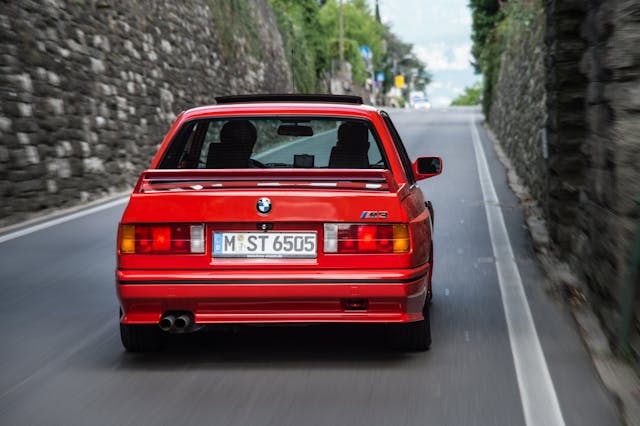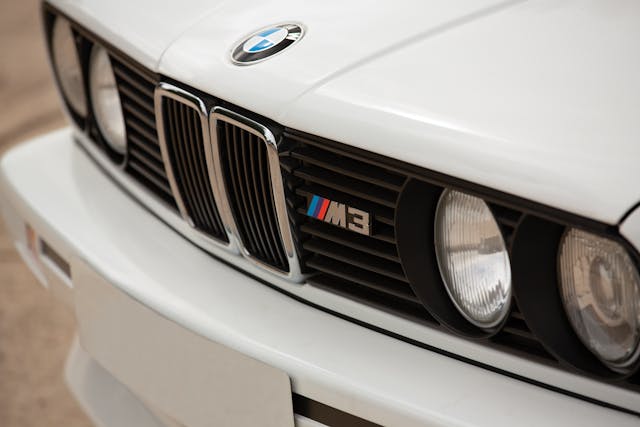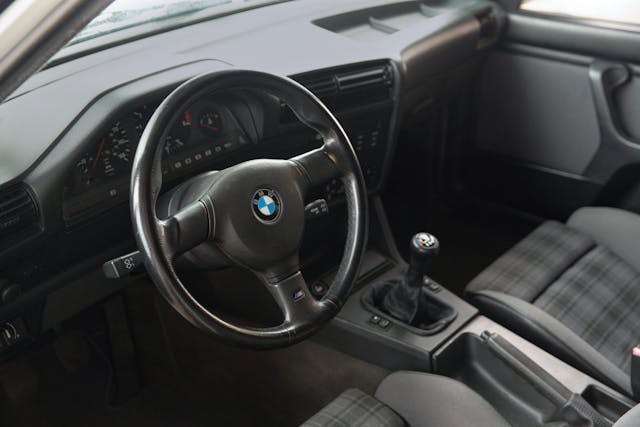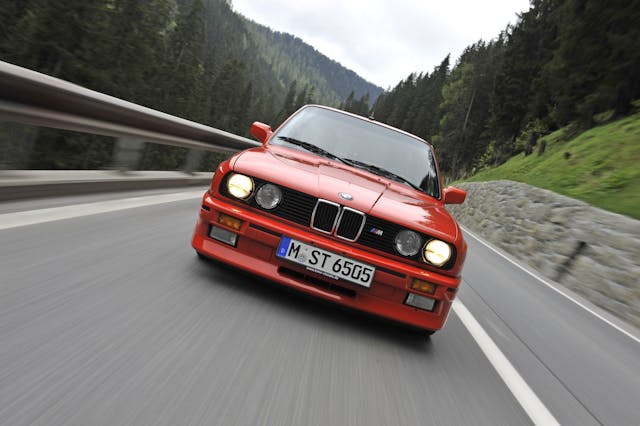Your handy 1986–91 BMW M3 (E30) buyer’s guide
It’s the first of many famous entry-level BMW touring cars to wear the coveted “M” badge. It’s the original 3 Series, crafted to meet the needs of the world of motorsport. For some, the first M3 is the best, and it’s hard to find fault with the E30’s lightweight, minimalist body paired to the engineering brilliance of the BMW M subsidiary. The E30 M3 has become a global motoring icon and perhaps an automotive mythological hero.
Model Overview
1986
Keen M Series fans know that the E30 M3 wasn’t available yet in the United States in ’86. However, let’s be clear on one thing: A Euro-spec E30 M3 is now easily imported stateside as a classic car with no restrictions, per NHTSA guidelines. Considering the rising value and growing appreciation for these models (more on that later), looking back at the ones we couldn’t get back then is even more important.
Everyone took notice when BMW introduced its DTM touring-car homologation special at the 1985 Frankfurt Motor Show, as this new M3 sported numerous exterior changes to the E30 coupe’s coachwork: wider fenders, deeper front and rear bumper valences, extended rocker panels, and a massaged C-pillar (which allowed for re-angled rear glass), plus a bold rear-deck spoiler and a unique, taller trunk. In all, these tweaks lowered the coefficient of drag from a moderate 0.38 to a far more sporting 0.33.

The motorsport-focused boffins at BMW M ensured the M3 backed up its style with impressive performance, starting with a suspension infused with more caster, five-lug hubs, beefed-up antiroll bars and relocated endlinks, stiffer and lower springs, and a clutch-type limited-slip differential. The M3’s brakes were also uprated, borrowing the four discs and Bosch ABS system from the E28 5 Series. The heart of the beast came from BMW’s S14 inline-four, with double overhead cams, four individual throttle bodies, machine-finished ports, solid lifters, an oil cooler, a robust 197 horsepower (192 when equipped with a catalyst), and a powerband that begged the driver to rev the engine hard to its 7250-rpm redline. A Getrag five-speed manual with a dogleg first gear sported close ratios that kept the S14 in its sweet spot.
The M3’s interior stood out from the crowd of conventional E30s thanks to unique sport seats; an M-specific shift knob sewn into its leather boot; uprated gauges (160-mph speedometer, 8000-rpm tach), and an M-Technic steering wheel. The luxury accoutrements one might expect from a BMW (air conditioning, power windows, sunroof, leather) were still available, but at extra cost. Even so, the E30 M3 started at 58,000 Deutschmarks (about $30,000 in period), nearly double the asking price of a conventional E30.
1987
Changes were modest for the M3 in its sophomore year, but it benefited from updates to the entire E30 lineup, namely BMW’s famous “ellipsoid” headlight reflectors and improved rustproofing. More important, ’87 marked the introduction of the first M3 Evolution (EVO I), which boasted a revised cylinder head, a few minor cosmetic changes, and 215 horsepower. Only 505 EVO Is were made, and Americans couldn’t get their hands on one—or on a regular M3, for that matter. At least, not yet.
1988

Everything changed for America in 1988: This was the first year you could buy an M3 in the United States. The main differences for the U.S.-spec car were a revised air intake (perhaps for EPA noise regulations), and the replacement of the dogleg transmission with a conventionally-arranged five-speed that also sported an overdrive fifth gear. With the taller fifth gear, U.S. cars received a 4.10:1 final-drive ratio.
Back in Europe, this year also heralded the next M3 Evolution (EVO II), bringing 220 hp, 16-inch BBS alloys, front brake ducts, thinner glass on the rear and side windows, a lighter decklid, and a slightly more aggressive body kit and spoiler. BMW only made 501 EVO IIs, and this was reportedly the first BMW to have an “M” plaque on the center console.
In order to celebrate the 1988 European Touring Car Championship title, Munich built 148 examples of another special model, the M3 Europameister. Each was finished in Macao Blue and sported BMW’s “Extended” gray leather interior (much of the cabin was wrapped color-matched hides, not just the seats). These cars bore a commemorative plaque signed by factory racing driver Roberto Ravaglia and 16-inch wheels.
1989
There were notable changes for all M3s this year, as mid-year improvements included the reintroduction of more conventional halogen headlights, fixed quarter windows, aluminum front control arms, an M-Technic II steering wheel (thicker rim and the “M” logo), and a power bump to 212 hp, even with a catalyst. New-for-’89 options included heated seats and a power glass moonroof. In September, a driver’s airbag became standard for U.S.-spec models, bringing with it a more sedate four-spoke steering wheel.
Much like last year’s Europameister, BMW made two M3 special editions for 1989: The Cecotto (505 units), after factory race ’shoe Johnny Cecotto, and a U.K.-exclusive M3 Ravaglia (25 units). Both models wore the body kit previous seen on the EVO II and were finished in unique colors (Misano Red, Macao Blue, or Nogaro Silver). They also featured a cam cover/intake manifold finished to match. Chrome tailpipes, thin rear-window glass, and a set of 16-inch BBS wheels with black centers rounded out the exterior upgrades, though the Ravaglia went a step further and included an adjustable spoiler. Each special edition received cloth seats and a commemorative interior plaque.

1990
While this year brought the safety of a driver’s-side airbag to non-U.S. M3s, the big news was the creation of the ultimate E30: The Sport Evolution (EVO III) began production in late 1989, and only 600 units were produced. Sport Evos wore a larger, 2.5-liter engine cranking out 235 horsepower, plus a unique front splitter and rear spoiler, brake cooling ductwork in lieu of driving lights, thinner glass, a smaller gas tank, a lower ride height, a lighter trunk, wider and recontoured fenders, and a redesigned front grille, the latter for better aerodynamics.
Only two colors were available: Glossy Black or Brilliant Red.
1991
The E30 M3 marked time for its final year, accumulating total sales of 5115 in America and just over 17,000 worldwide. While there may be a handful of American 1991 M3s titled as 1992 models, rest assured they were indeed made in 1991 and simply sat in dealer inventory long enough to require the nominal year change.
Before you buy
The reasons for owning a BMW E30 M3 are plentiful, but there are numerous issues worth considering before committing to a purchase. Probably the most important aspect is proof of service and maintenance: for example, valve adjustments need to happen every 30,000 miles. Rust can be a concern, so check around the license-plate lights, sunroof drains, frame rails, the edges of the body where windshield glass was bonded, the wheel arches, rocker panels, around the taillights, the rear subframe and shock towers, the floorpans, and the battery tray. Accident damage is likely—many E30 M3s were tracked and/or driven hard on the road—so keep an eye out for low-quality paint and body work, and be wary of damage around the radiator support and inside the trunk.

The condition of an M3’s interior is a great indicator of the quality of its ownership history. Aside from evaluating the general condition of the dashboard, carpets, seats, and electronic equipment, look for the numerous items unique to the M3, including the bespoke front and rear seats, the black headliner, the black C-pillar covers, and the unique gauge cluster. Having all the original equipment, including the factory BMW stereo, bodes well for the quality of the M3 in question. If any parts are missing, price replacements online and factor them into the asking price. Speaking of originality, closely inspect the wheels to confirm whether they are M3-specific: Many other five-lug BMW basket-weave wheels look similar but have a different offset. (Factory-spec M3 rims use a +24 mm offset; special editions, +27 mm.)

Outside of owner maintenance and level of abuse over time, E30 M3s display precious few mechanical issues. Oil leaks are common and rear shock mounts tend to have short lifespans, so listen for a clunk over bumps during a test drive. The S14 engine can be hard on engine mounts, so pay attention to vibrations that are pronounced enough to make the cabin annoyingly buzzy—they may need to be replaced.

Because M3s are motorsport-oriented, there’s a good chance the example in question has been on a track. That’s not necessarily a cause for concern, provided that its owner has maintained the car accordingly. (For example, rod bearings are considered a maintenance items on tracked engines.) Be on the lookout for heavy track use (without a stiffening roll cage) by looking for a dent in the roof as the body shell flexes. A former race car may been converted back into a street car, so look for signs of poorly refilled cage mounting holes, body filler from crash damage, missing exhaust parts, damaged bumper covers, aftermarket chips added to the engine-management computer, or missing interior/exterior parts. This last bit isn’t necessarily a deal-breaker, since former race M3s will sell for significantly less than a street car.
Valuation
The Hagerty Valuation team has gained insight into recent transaction prices, but please check here for the most up-to-date values. Unsurprisingly, the highest-valued models in the E30 lineup are the Sport Evolution variants: They normally draw double the price of a contemporary M3. That said, the E30 M3 started to appreciate at a rapid pace starting in 2013–2014 and kept the momentum going through 2018. During that period, the median #2 value increased by an eye-popping 324 percent, though things have quieted since 2019.
The uptick in E30 M3 values has influenced all M3s made on the E36 and E46 chassis. While they have appreciated, however, their trajectory isn’t as radical as that of E30 M3s. To date, Bring a Trailer has sold six E30 M3s for over $100,000, including an 8000-mile original for a quarter-million dollars. Hagerty’s median quoted value is currently set at a more reasonable $51,112, but that number rose 38 percent over the past five years.

The demographic breakdown for E30 M3s likely comes as no surprise for fans of vehicles made in the go-go 1980s. Pre-boomer interest is slim (1 percent), with the lion’s share of E30 M3 quotes coming from Gen-Xers (41 percent) and millennials (31 percent). Boomers are paying attention, too, though at 27 percent they account for a smaller slice of our quote data for this model.
The fact remains that the meteoric rise in E30 M3 values has drawn an extraordinary amount of attention to this vehicle, which has invited a cacophony of opinions on the most desirable configuration. No matter your reasons for purchasing the first BMW M3, always remember to find the right example: one that suits your tastes, comes with a service history, and is in the best condition your budget will allow. Happy hunting.


